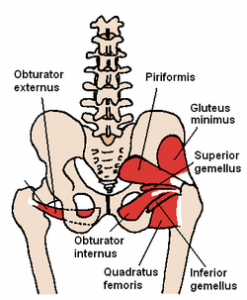I have been a bit behind on blogging as of late. I try to aim for one per week, but I also strive to deliver sound and relevant content. Additionally, I do not seek outside contributors so finding time to write can be tricky with work and family life too. So, forgive me for any apparent inconsistency in posting. Just know that I will always try to provide valuable content. Today’s post centers around an article in the July 2012 edition of AJSM.

My work at the Athletic Performance Center has provided me an increased opportunity to work with FAI and athletic hip injuries. This is an area of evolution and growth in our field, so I find it particularly interesting to see rationale and thought processes centering around the timing, contribution and selection of hip exercises for active patients/athletes.
This article comes from the Steadman Philippon Research Institute in Vail, CO. The purpose of the study was to measure the highest activation of the piriformis and pectineus muscle during various exercises. The hypothesis was that highest pectineus activation would occur with hip flexion and moderate activity with internal rotation, whereas the highest activation with the piriformis would be with external rotation and/or abduction.


Methods: 10 healthy volunteers completed the following 13 exercises:
- Standing stool hip rotation
- Supine double leg bridge
- Supine single leg bridge
- Supine hip flexion
- Side-lying hip ABD with external rotation
- Side-lying hip ABD with internal rotation
- Side-lying hip ABD against a wall
- Hip clam exercise with hips in 45 degrees of flexion
- Hip clam exercise with hips in neutral
- Prone heel squeeze
- Prone resisted terminal knee extension
- Prone resisted knee flexion
- Prone resisted hip extension
All of these exercises have been reported to be used in hip rehab following arthroscopy or recovery from injury. The exercises were executed slowly and methodically with a metronome to reduce EMG amplitude variations.
RESULTS
Pectineus
- Highest activation with supine hip flexion in concentric phase
- Exercise with hip ABD and/or hip extension were found to have low (< 20%) activation except for single leg bridge (peak amplitudes at 26.5%)
- Single leg bridge was much higher than any of the prone or side-lying exercises
Top (3) Pectineus Exercises
- Supine hip flexion
- Single leg bridge
- Double leg bridge
Hip flexion sequence (top to bottom pictured below with image from AJSM):

Piriformis
- 4 of the 10 participants were removed due to inactive EMG signal or demonstrated significant spikes and other artifacts during motion
- Highest activation occurred during resisted hip extension in concentric phase
- Highest activation with eccentric phase of exercise occurred with single leg bridge
- Side-lying hip ABD in external rotation and prone heel squeeze were found to have similar levels of peak EMG as the resisted hip extension and single leg bridge
Top (3) Piriformis Exercises
- Prone heel squeeze
- Single leg bridge
- Single leg hip ABD with external rotation
Prone heel squeeze finish position (in slight hip extension) pictured below with image from AJSM:

** Note: The top three final rankings for each muscle group were based on peak and mean EMG amplitudes in concentric and eccentric phases of the exercises.
Article Takeaways
The pectineus was not very active in rotation (internal or external). Its increased activity in the bridges indicate it is an important hip stabilizer and involved in preventing external rotation. It is also likely pivotal in closed chain sports activity like acceleration and pivoting movements. The authors specifically feel it is key to sports such as dance, soccer, basketball, hockey and ice skating.
The piriformis was most active when stabilizing/maintaining external rotation as evidenced by the prone heel squeeze and single leg bridge. The highest levels surprisingly occurred in activities that required hip extension and/or were performed in hip extension. Therefore, the muscle would seem to function most as a an external rotation stabilizer maintaining hip position as the thigh extends. The authors note that this would mean it is vital in controlling/guarding against internal rotation with toeing off in running, jumping, or the skating stride as well as limiting internal rotation coming out of such athletic positions.
The authors feel their findings indicate limiting external rotation after hip surgery may also cause deconditioning of the piriformis. While necessary to protect healing tissues, they speculate this functional weakness may lead to knee valgus and increased hip internal rotation. More research needed on this one.
Limitations in this study include: small population of subjects, no ADD (adduction) exercises to measure pectineus activity, only one exercise with combined ER/IR and trouble with electrodes for EMG on the piriformis.
Click here for the article abstract
My personal thoughts
I think we always need to consider how we function in weight bearing as we look at these studies and activation patterns. There is of course a time for isolation strengthening in early rehab aimed at turning the muscles on if you will, but the body is sophisticated and all these muscles do work together either in synergy or antagonistic ways. Dynamic stability is often lost due to poor neuromuscular patterning or weakness. The body gives way to gravity and poor motor memory in the absence of adequate stabilization.
I was telling the ATC that works with me at the clinic just the other day that resisting forces is just as important if not more so for our athletes when the aim is injury prevention and fine motor control. We often get caught up in strengthening to produce performance and movement but we must not lose sight of the importance of restraining unwanted movement through proper muscle activation. I think this little study reminds us of that very important message.

